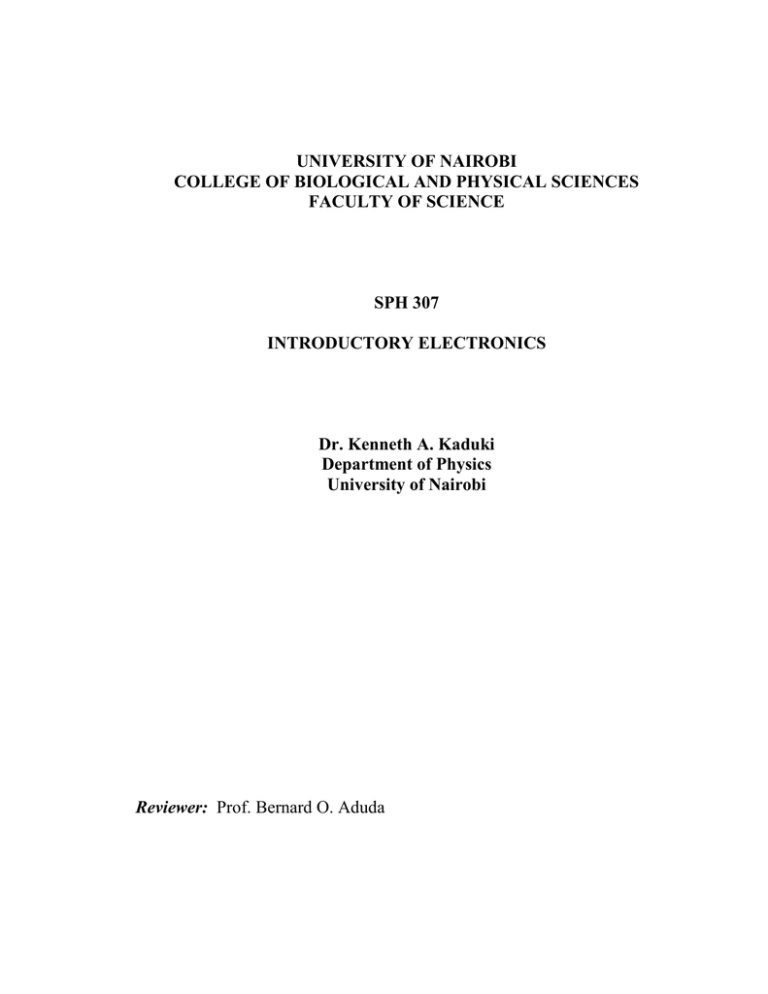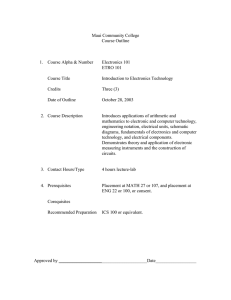introductory electronics - School of Physical Sciences
advertisement

UNIVERSITY OF NAIROBI COLLEGE OF BIOLOGICAL AND PHYSICAL SCIENCES FACULTY OF SCIENCE SPH 307 INTRODUCTORY ELECTRONICS Dr. Kenneth A. Kaduki Department of Physics University of Nairobi Reviewer: Prof. Bernard O. Aduda SPH 307 INTRODUCTORY ELECTRONICS INTRODUCTION All of us have used electronic equipment of one type or the other. Most of our homes have radios and, increasingly, television and electronic apparatus of other kinds are being considered as standard domestic equipment. Mobile phones, personal computers, and CD players provide further proof that electronics is vital to a developing economy like ours. This series of ten lectures is intended as an introduction to the exciting field of electronics for students with no prior knowledge of the technical aspects of the subject. The primary goal of the lectures is to present the basic principles of operation of electronic devices and demonstrate their utilization in circuit applications. You will also be introduced to the analytical tools and techniques required to solve a variety of practical problems in electronics. Learning Objectives: Upon completion of this study unit you should be able to: Apply Kirchoff’s laws to electronic circuits and derive the basic equations Apply the following fundamental techniques for the analysis of resistive circuits: superposition theorem; Thevenin’s theorem; Norton’s theorem. Describe the basic principles underlying the physics of semiconductor devices in general and the PN junction in particular. Explain the operation of selected diode-based circuits. Describe the operation of transistors. Determine and select the operation point of transistors. Draw transistor amplifier circuits and explain how they work. Describe the process of Integrated Circuit (IC) manufacture. Compute the gain of Simple Operational Amplifier–based amplification circuits. List the major classes of sensors and explain the principle of operation of selected sensors. Describe the principle of operation of various optoelectronic devices. ii The material is in the following order: I start by presenting Kirchoff’s laws and network theorems. These two lectures will provide the ‘tools’ you require for the systematic analysis of a wide range of direct current (dc) circuits. In lecture 3, I present semiconductor theory, the diode (pn junction) and diode characteristics. Lecture 4 introduces a few basic diode–based circuits. In lectures 5 to 7, I discuss the construction and characteristics of transistors and show how they can be assembled into basic voltage amplifiers. Integrated circuits (ICs) have led to a ‘systems’ approach to electronics. In lecture 8, I present a brief section on the manufacture of ICs. This is followed by a discussion of the characteristics and basic applications of the Operational Amplifier (Op Amp) – the most commonly used linear IC. The last two lectures provide an introduction to transducers and optoelectronic devices respectively. I have included a number of questions and exercises after each lecture summary. You should attempt these questions before advancing to the next lecture. Self–test questions are also provided at various points of each lecture. You should attempt these questions before moving on to the material that follows. Answers to the self–test questions are provided at the end of each lecture. The text books listed below are useful references for most of the material presented in this study unit: 1. A. P. Malvino, Electronic Principles, Tata McGraw-Hill Publishing Company Limited, New Delhi (1999) 2. R. Grob, Basic Electronics, Tata McGraw-Hill Publishing Company Limited, New Delhi (1997) Please feel free to point out any errors that you come across as you read these lecture notes. Dr. Kenneth Amiga Kaduki Senior Lecturer, Department of Physics, Faculty of Science, University of Nairobi April 2005 iii CONTENT PAGE INTRODUCTION ii LECTURE 1: KIRCHOFFS LAWS 1.1 Introduction 1.2 Basic Circuit Elements 1.3 Kirchoff’s Current Law (KCL) 1.4 Kirchoff’s Voltage Law (KVL) 1.5 Method of Branch Currents 1.6 Node–Voltage Analysis 1.7 Method of Mesh Currents 1.8 Summary 1.9 Exercises 1 1 2 5 7 11 15 19 20 LECTURE 2: NETWORK THEOREMS 2.1 Introduction 2.2 Superposition 2.3 Thevenin’s Theorem 2.4 Thevenizing a Circuit with Two Voltage Sources 2.5 Thevenizing a Bridge Circuit 2.6 Norton’s Theorem 2.8 Summary 2.9 Exercises 22 22 25 29 31 33 38 38 LECTURE 3: SEMICONDUCTORS 3.1 Introduction 3.2 Semiconductors 3.3 Electrons and Holes 3.4 Extrinsic Conductivity 3.5 Majority and Minority Carriers 3.6 Compensation 3.7 The pn Junction 3.8 Biased pn Junction 3.9 Avalanche Breakdown 3.10 Summary 3.11 Exercises 40 40 42 43 44 45 45 46 48 52 53 LECTURE 4: DIODE CIRCUITS 4.1 Introduction 4.2 The Half–Wave Rectifier 4.3 The Full–Wave Rectifier 4.4 Waveform Filtering (Smoothing) 4.5 Voltage–Doubler Circuit 4.6 Clippers and Clampers 4.7 Summary 4.8 Exercises 54 54 55 58 62 63 65 65 iv 5. 6. 7. 8. 9. BIPOLAR JUNCTION TRANSISTOR (BJT) 5.1 Introduction 5.2 Construction and Symbols of the BJT 5.3 Transistor Action 5.4 Transistor Currents 5.5 The Common Emitter (CE) Characteristics 5.6 Summary 5.7 Exercises 67 67 69 71 73 78 79 VOLTAGE AMPLIFICATION 6.1 Introduction 6.2 Load Resistor 6.3 Working Point and Bias 6.4 Coupling Capacitors 6.5 Stabilizing the Operating Point 6.6 Fully–Stabilized Voltage Amplifier 6.7 Constant–Emitter–Current Bias 6.8 DC Load Line and Collector Bias 6.9 Measurement of the Voltage Gain 6.10 Summary 6.11 Exercises 80 80 81 82 84 86 87 89 93 93 93 FIELD EFFECT TRANSISTOR (FET) 7.1 Introduction 7.2 Construction and Symbols of the JFET 7.3 Terminal Characteristics of the JFET 7.4 Bias Line and Load Line for JFET Amplifier 7.5 Establishing Bounds on Q-Point Location 7.6 Graphical Analysis of JFET Amplifiers 7.7 Transconductance 7.8 Construction and Symbols of the MOSFET 7.9 Terminal Characteristics of the MOSFET 7.10 Summary 7.11 Exercises 95 96 98 101 104 105 106 107 108 110 110 INTEGRATED CIRCUITS 8.1 Introduction 8.2 Manufacture of Integrated Circuits 8.3 Ideal and Practical Operational Amplifiers (Op Amps) 8.4 Op Amp–based Amplification Circuits 8.5 Wein Bridge Oscillator 8.6 Summary 8.7 Exercises 112 112 117 119 125 127 128 TRANSDUCERS 9.1 Introduction 9.2 Classification of Transducers 9.3 Thermistor 9.4 Thermocouple 9.5 Resistance Temperature Detector (RTD) 9.6 The Linear Variable Differential Transformer (LVDT) 130 130 133 135 136 138 v 9.7 9.8 9.9 10. Strain Gauge Summary Exercises 139 141 142 OPTOELECTRONIC DEVICES 10.1 Introduction 10.2 Light Sources 10.3 Light Detectors 10.4 Optocouplers 10.5 Summary 10.6 Exercises 144 145 150 152 153 153 vi
